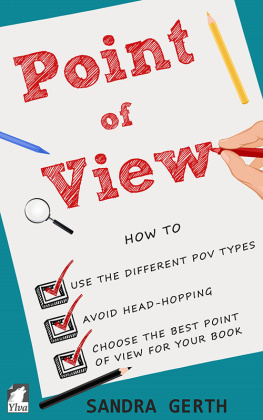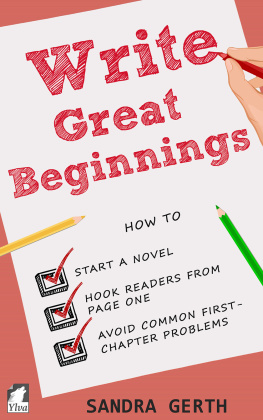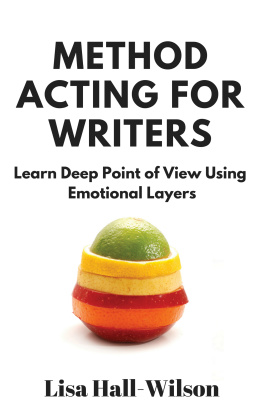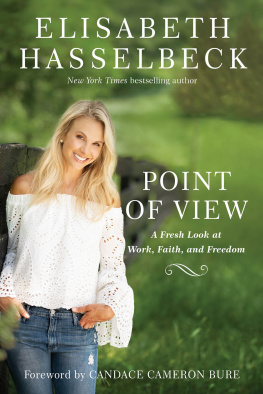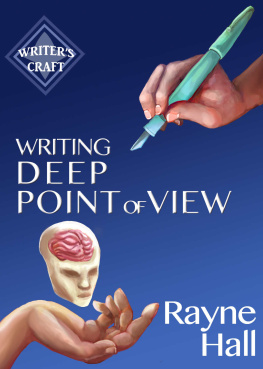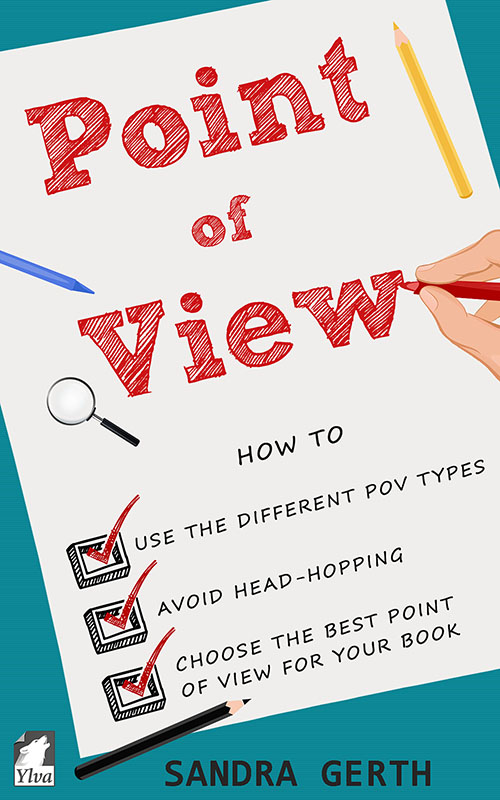Books in the
Writers Guide Series
Goal Setting for Writers
How to set and achieve your writing goals, write a book, and become a successful author
Time Management for Writers
How to write faster, find the time to write your book, and be a more prolific writer
Show, Dont Tell
How to write vivid descriptions, handle backstory, and describe your characters emotions
Point of View
How to use the different POV types, avoid head-hopping, and choose the best point of view for your book
Table of Contents

1. Introduction
What this book will teach you
Point of view (POV) is probably the most powerful tool in a writers tool kit, but its also one of the hardest to understand and master.
As the senior editor of a publishing house, I encounter POV violations in submitted manuscripts from new writersand even from more experienced authorsevery day. Often, we end up rejecting these manuscripts because point of view has such a strong impact on every aspect of the story that fixing fundamental point of view mistakes would take too much time.
The manuscripts we accept for publication, however, are often written by authors who clearly know how to handle point of view. If you as a writer have a good grasp on POV, you can make readers identify with your main character, draw them into the story, and keep them captivated from the beginning until the very last page.
If that is what you are aiming for with your writing, this is the book for you.
Whether youre a novice writer working on her first story or an established author who has already published multiple novels, this book will help you to:
discover what point of view is and why its so important;
understand the different types of point of view as well as their advantages and disadvantages;
choose the point of view that works best for your story;
write a novel from multiple viewpoints and shift between different POVs without confusing your readers;
avoid head-hopping and other POV violations that would throw your readers out of the story;
write a story from a deep, intimate point of view that will draw your readers into the story;
find solutions to common point of view problems such as describing your POV character;
write internal monologue and take your readers deeply into your characters mind;
create suspense and tension by using POV techniques;
make your readers experience events through your characters eyes to get them emotionally involved in your story.
HOW TO GET THE MOST OUT OF THIS BOOK
Each section of this book ends with an exercise that invites you to reflect on your own opinions and experiences or that will help you improve your POV skills. Many of the exercises will also have you work on your own story, either a work in progress or one that you have written in the past. If you havent started writing a novel yet, there are exercises that will guide you through choosing the best point of view for your story.
I suggest that you get a notebook or several sheets of paper and a pen. While youre reading this book, stop after every chapter and do the exercises. By the time you finish this book, youll know which point of view you will use for your story if you havent started writing it yet or, if you have already written the first draft, which POV violations you need to correct.
By the way, a few of the examples I use throughout this book are from my own novels, written under my pen name, Jae (jae-fiction.com). I do that strictly for legal reasons, to make sure Im not violating anyones copyright. A few of the examples are based on manuscripts I edited, rewritten to protect the innocent.
Happy reading and writing!
Sandra Gerth
2. Definition
What point of view is and why its so important
Have you ever watched a movie that was based on a novel that you had read? If you did, which did you like betterthe novel or the movie?
If you are anything like me and most other people, you probably prefer the book over the movie most of the time. The reason for that preference is point of view. Ill explain that in a second, but lets define what point of view is first.
DEFINITION OF POV
The narrative point of viewoften shortened to POVis the perspective from which a story or at least a section of the story is told. Its like a lens through which readers view the events.
Heres why POV is the reason most people prefer the book to the movie based on the book:
POV makes reading a book a more intimate experience compared to other forms of storytelling such as movies and TV shows. In novels and short stories, readers arent limited to seeing just the outer actions and hearing the dialogue. They get to dip into the minds of the characters, see the events through their eyes, and experience their emotions. They are becoming the protagonist and living the story instead of just watching it. Thats why as readers, were often much more emotionally involved in books than movies.
THE IMPORTANCE OF POV
POV isnt just another element of the writing craft; its the foundation that will help you write a great book and avoid problems with the other core elements of fiction:
Point of view determines how readers will view your characters, how close they feel to them, and with whom they will identify.
Point of view helps you create tension and suspense by controlling how much information you give your readers about whats going on in the story. Readers will keep turning the pages if they get to discover what will happen next along with the POV character.
A close point of view encourages you to show instead of tellwhich basically means bringing the story to life instead of delivering a secondhand report. If you want to find out more about showing and telling, take a look at my nonfiction book Show, Dont Tell. How to write vivid descriptions, handle backstory, and describe your characters emotions.
So you can see how important it is to understand point of view. Still, many writers, not just new ones, struggle with it.
You might think that it doesnt matter because readers dont know what point of view is anyway. Well, readers will notice the effects of POV problems, even if they most often wont be able to pinpoint it as such. What theyll typically say instead is that they couldnt warm up to the main character or found it hard to get into the story.
EXERCISE #1:
Take a look at your DVD collection or try to remember the movies you have seen that are based on novels you have read.
Are there any books you liked better than their movies? If yes, what were you missing in the movies? What made reading the novels a more enjoyable experience?
Can you think of any movies that were better than the books that inspired them? If yes, what did these movies have in common?
What makes the movies you preferred to the books different from the movies you didnt enjoy as much as the books? In other words, what kind of novel works as a movie and what kind doesnt? For example, does a certain genre or a certain type of main character or a certain kind of plot work better than others? Can you see a connection to point of view?
3. Types of POV
What the most commonly used points of view are
As you probably know, theres not just one point of view; there are several different types and subtypes. Ill give you an overview in this chapter and then explain each point of view in more detail in the next chapters.

